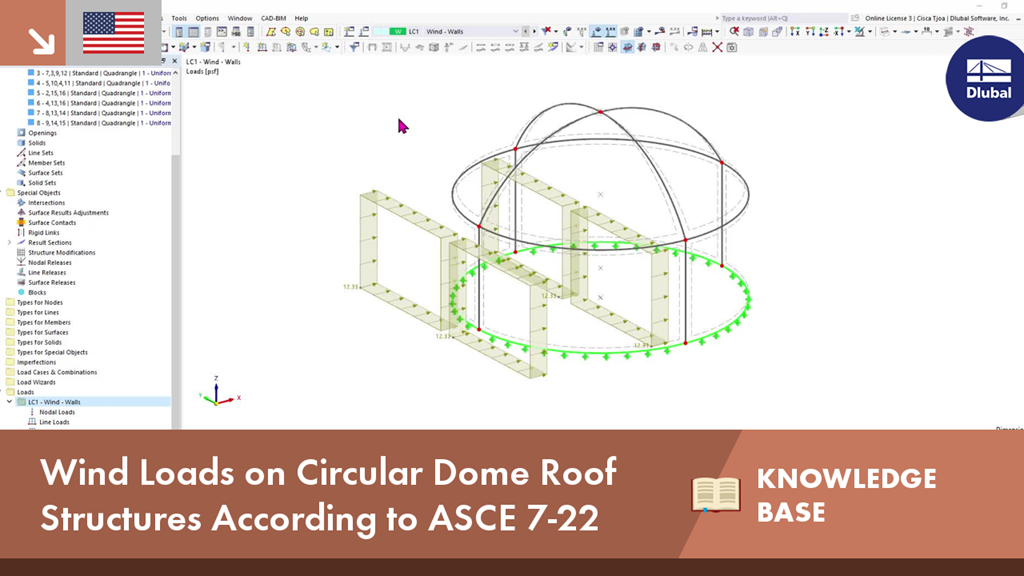Subject:
Wind Loads on Circular Dome Roof Structures According to ASCE 7-22
Comment:
When it comes to wind loads on building type structures as per ASCE 7, numerous resources can be found to supplement design standards and aid engineers with this lateral load application. However, engineers may find it more difficult to find similar resources for wind loading on non-building type structures. This article will examine the steps to calculate and apply wind loads as per ASCE 7-22 on a circular reinforced concrete tank with a dome roof.
Description:
Determining Wind Loads from ASCE 7-22
Table 29.1-2 in ASCE 7-22 [1] outlines the necessary steps to determining the wind loads on a circular tank structure according to the Main Wind Force Resisting System (MWFRS).
Step 1: The Risk Category is determined from Table 1.5-1 [1] based on the use or occupancy of the building. Dome structures may be utilized as storehouses, which pose a relatively low risk to human life. On the other hand, domes are also used in the design of sports stadiums, which can have an extremely high impact on human life in the event of a failure.
Step 2: After determining the Risk Category from Step 1, the Basic Wind Speed (V) can be found in Figs. 26.5-1 and 26.5-2 [1]. These figures display the 3-s gust wind speed maps for the United States, which vary depending on the location and Risk Category of the structure. Linear interpolation is permitted between the given contour lines.
Step 3: There are multiple wind load parameters required in this step which ultimately influence the wind load pressure.
The Wind Directionality Factor (K-d) from Table 26.6-1 [1] is given as 1.0 for circular domes and round tanks.
Considering two wind directions, the Exposure Category is set based on the topography, vegetation, and other structures on the upwind exposure side. The higher the Exposure Category (that is, Category D), the more exposed the structure may be.
The Topographic Factor (K-zt) considers wind speed-up over hills, ridges, and escarpments. This value is calculated in Equation 26.8-1 [1] using the factors K-1, K-2, and K-3 given in Figure 26.8-1 [1].
K-zt = (1 + K-1K-2K-3)²
The K factors from Figure 26.8-1 [1] depend on the terrain such as hill height (H), distance from the crest to the site of the building (x), height above the ground surface (z), and so on.
Table 26.9-1 [1] gives the Ground Elevation Factor (K-e) based on the structure's elevation above sea level. This factor can also be conservatively taken as 1.0 for all elevations.
The Enclosure Classification can be determined in Section 26.2 [1]. Openings in the structure may have an influence on this classification. In many cases for storehouses, the enclosure classification is considered "closed". For sport stadiums, however, this may depend on the structure's wall openings, retractable roof, and so on.
Depending on the Enclosure Classification, the Internal Pressure Coefficient (GC-pi) as both a positive and a negative value to account for pressure acting toward and away from the internal surfaces can be found in Table 26.13-1 [1].
The Gust-Effect Factor (G) depends on the structure's stiffness definition as rigid or flexible from Section 26.2 [1]. The fundamental natural frequency plays an important role in determining this classification. The Modal Analysis add-on in RFEM 6 can be utilized to find the structure's fundamental natural frequency. Section 26.11 [1] gives the relevant formulas to calculate G for rigid or flexible structures. Alternatively, 0.85 is permitted to be used for rigid structures only.
Step 4: The Velocity Pressure Exposure Coefficient (K-z) can be found in Table 26.10-1 [1] based on the Exposure Category. Two K-z values should be determined on the basis of the mean wall height of the dome and the mean roof height of the dome. Linear interpolation can be used for intermediate height values.
Step 5: The Velocity Pressure (q-h) is determined from Equation 26.10-1 [1].
q-h = 0.00256K-zK-ztK-eV²
All variables in this equation were determined in the previous steps. Two q-h values should be calculated to be used in a later step. The first will be q-h at the height of the wall centroid and the second based on the mean dome roof height, which are dependent on the K-z values from Step 4. The subscript notation q-h vs. q-z is used interchangeably in Equation 26.10-1 [1] depending on the velocity pressure evaluated for walls versus the roof, respectively.
Step 6: The Force Coefficient (C-f) for walls of an isolated dome in Section 29.4.2.1 [1] can be set to 0.63, where h-c/D is in the range of 0.25 to 4.0 with h-c = solid cylinder height and D = diameter. C-f for walls of grouped domes is calculated on the basis of Figure 29.4-6 [1].
Step 7: The External Pressure Coefficient (C-p) for a dome roof with a roof angle greater than 10° is determined in Figure 27.3-2 [1...
